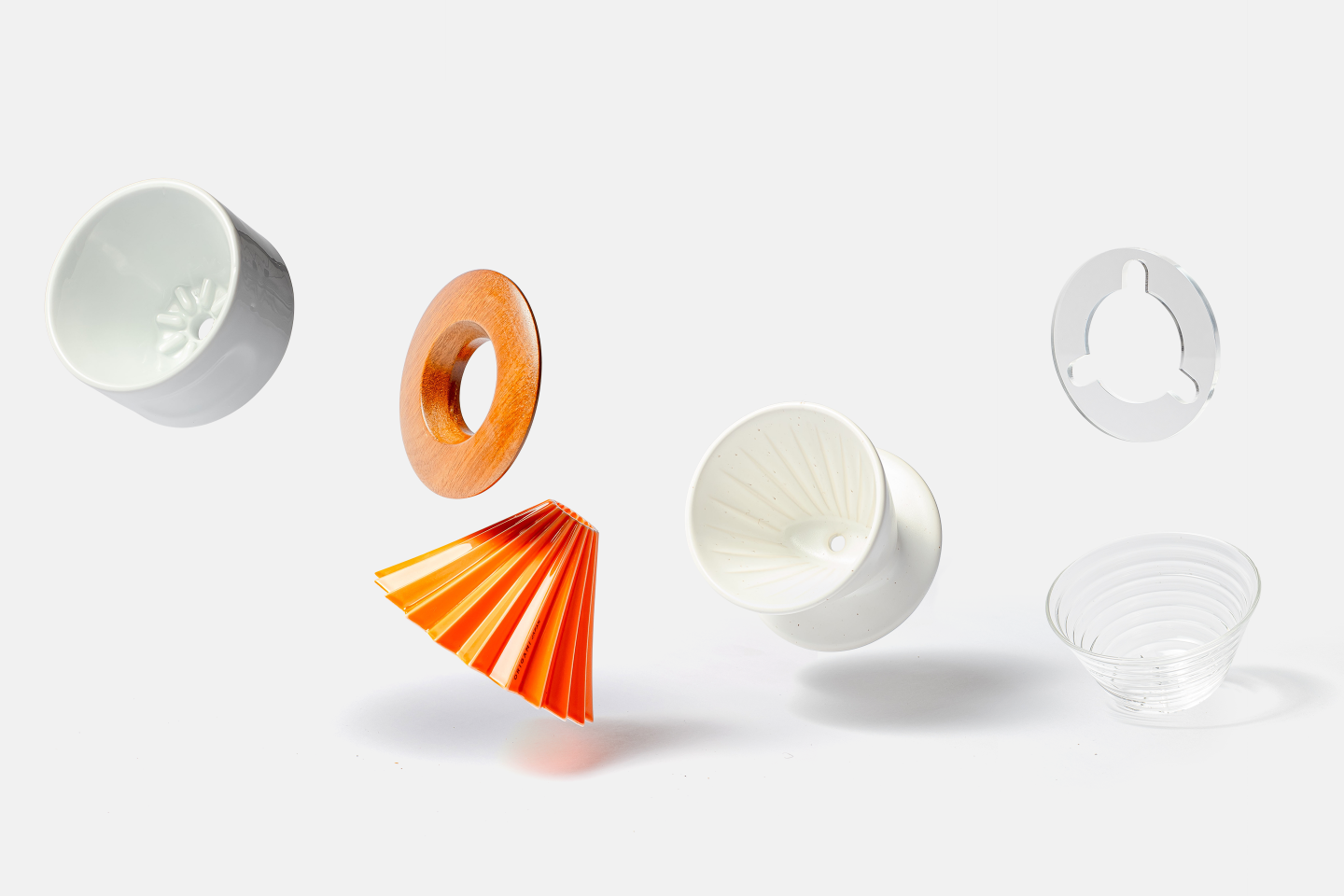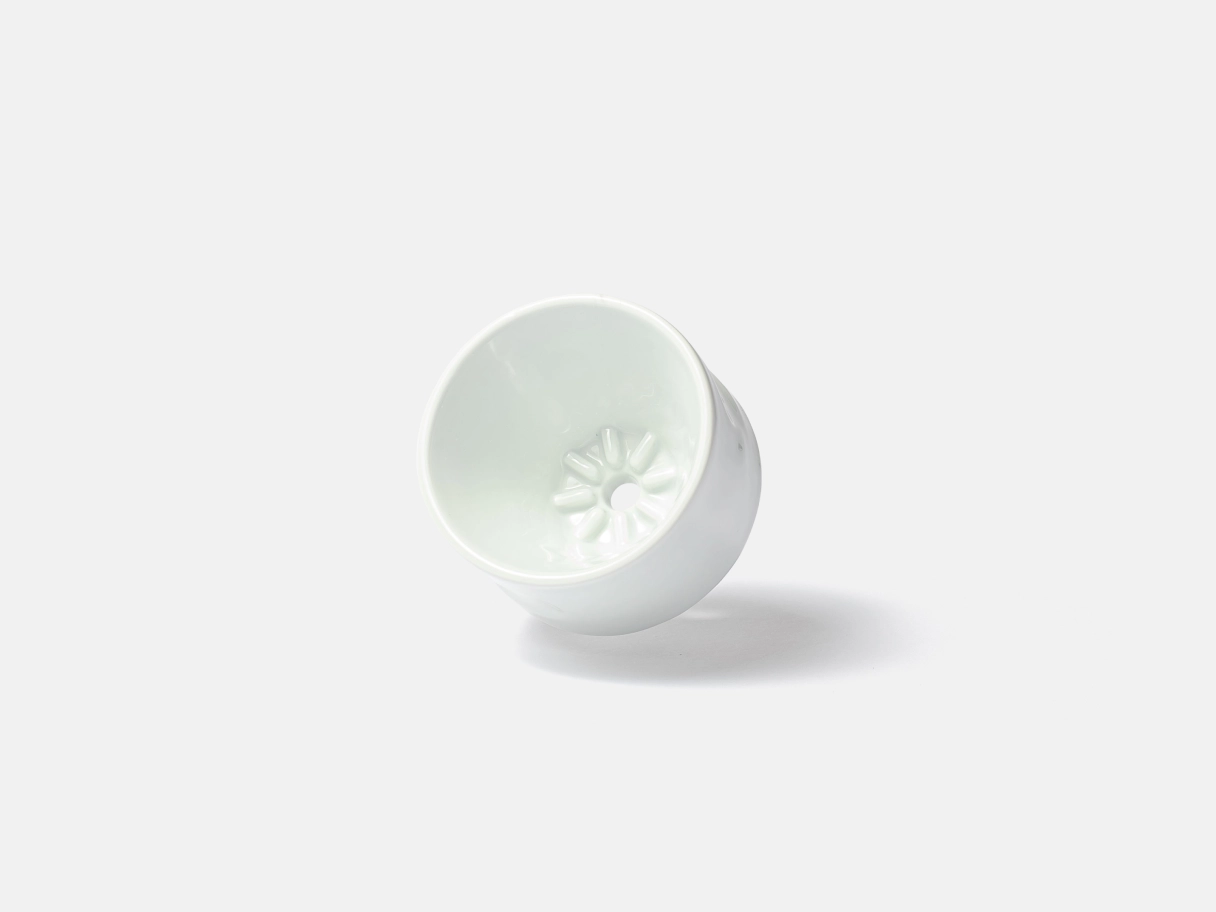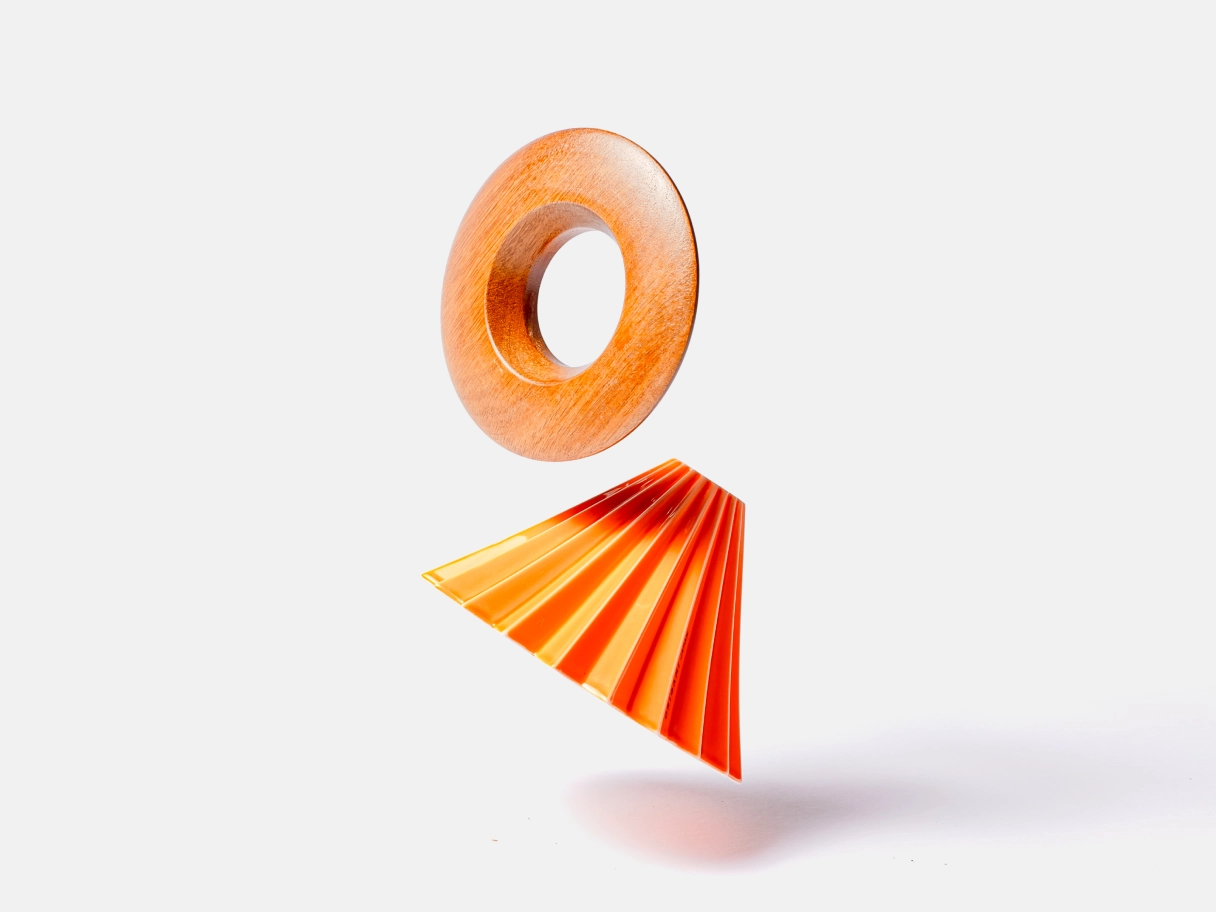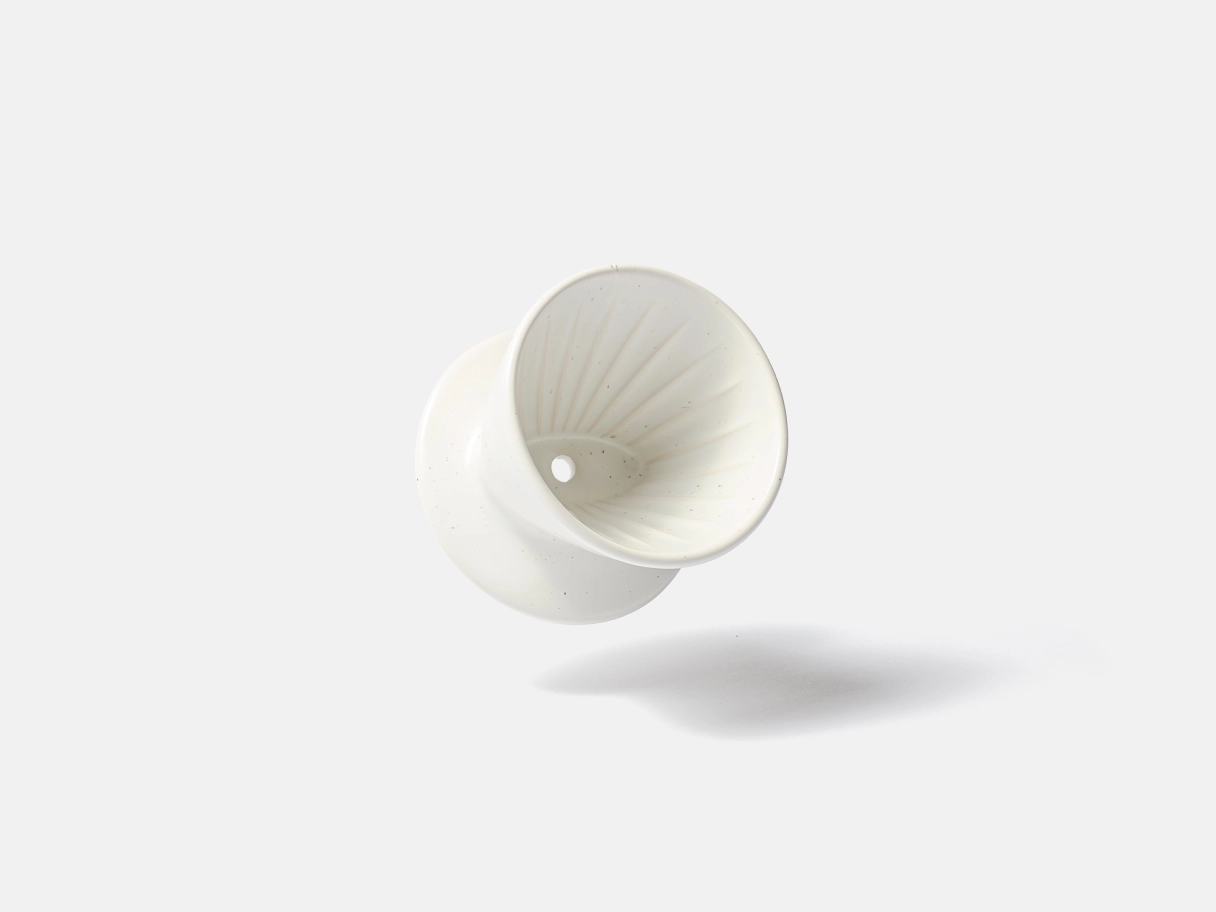

Pour over coffee occupies a sweet spot in the coffee-making landscape, balancing simplicity, accessibility, and creativity. All that is needed is a coffee dripper, a burr grinder, and a hot water source. If using a stove-top water kettle, no electronic devices are needed.
The dripper (also known as a brewer), given its incredible mechanical simplicity, is the most affordable type of coffee makers, making a great cup of coffee accessible to a wide audience.
The manual nature of pour over coffee introduces creativity. Variables like grind size, water temperature, pouring technique, coffee dripper shape, and filter material pose both challenges and opportunities. Through experimentation and observation, every person can discover their favorite way of making coffee.
In this guide, I recommend four drippers that can function as conversation pieces when not in use and produce great-tasting coffee. Each has different aesthetics and produces a different cup of coffee.
This minimal dripper is easy to use and provides consistently sweet and clean cups of coffee.

Meaning “effective” in Turkish, Etkin is a Turkey-based producer of coffee drippers founded by coffee instructor and consultant Michael Butterworth. Their first product, the 8-cup dripper, was designed to accept commonly found basket filters in producing large batches of pour over coffee.
This 2-cup dripper is a smaller variation on that original design, maintaining the goal of producing sweet and clean cups of coffee. Both are entirely designed and made in Turkey from porcelain.
This dripper features timeless aesthetics — a cylindrical shape with oval-shaped handholds. The form and finish are reminiscent of the TC 100 dinnerware that Nick Roericht designed at HfG Ulm. Though the aesthetics are minimal, they are anything but plain.
This dripper has a flat bottom, a feature that leads to consistency. To counteract stalled brews, ridges at the bottom elevate the filter. These ridges are modeled after the ridge pattern on the 8-cup dripper seen in the Etkin logo.
A single large hole in the middle mitigates bypass. The double-walled design ensures temperature stability and the ability to pick up and swirl the dripper at any time.
The base is wide enough and the bottom spout small enough that I could use this dripper with every mug and server I have at home. At the bottom are three small holes that are remnants of the slip casting process used in production. The glossy glaze is easy to clean, but not too slippery to hold. Small imperfections are beautiful reminders of the handmade nature of this product.
The strong structure and timeless aesthetics will make this dripper very long-lasting. In the worst case that this dripper breaks, it can be recycled at a speciality recycler that handles porcelain.
Using a Kalita 155 ruffled filter, I achieved very consistent, sweet, clear cups of coffee. I used the pulse method recommended by Etkin. It’s the same method I use for other flat-bottom brewers like the Kalita Wave.
Normally, the risk with flat bottom brewers is that the brew can stall and lead to bitter results. In this regard, the ridges and single small hole shined. I enjoyed every single cup I made with this dripper.
This eye-catching dripper, available in a large variety of finishes, has been used to win the World Brewers Cup twice.

The ORIGAMI Dripper was designed by Yasuo Suzuki, and Kiyohito Tanaka of Trunk Coffee in Nagoya, Japan. As it’s name suggests, it looks like folded paper. This dripper has grown in popularity over recent years, especially after Jia Ning Du used one in 2019 and Carlos Medina used one in 2023 to each win the World Brewers Cup .
There are two versions, each in two sizes. The Air line is made of AS resin, while the standard one is made from Mino porcelain. Both come in a small S and a medium M size. I chose the porcelain M model.
The porcelain dripper, alongside ORIGAMI’s other porcelain products, is made in a factory in Japan’s Gifu prefecture, an area with centuries-long history of ceramic making.
Aesthetically, it’s one of the most striking, yet beautiful drippers on the market. Available in a dazzling range of colors, it can blend in to its surroundings or stand out as a conversation piece. The glaze is even and thick across the flat surfaces, but is thin in the edges, exposing the white porcelain underneath. This variation in color accentuates the sharp geometry.
The ORIGAMI dripper is most commonly used with a collar, either made of wood or resin. There is also a huge range of ORIGAMI accessories, including porcelain cups, and an elegant glass server that obviates the need for a collar.
Designed with 20 creases, the origami dripper can perfectly accommodate the ruffles of Kalita Wave filters. It also accepts cone-shaped Hario V60 filters, which were my choice. The 20 creases are not just an aesthetic component, they create air channels for temperature and flow control just like the spout in a Chemex or the swirling ridges in a Hario V60.
The dripper is very precisely made, showing no imperfections. The wooden collar, given that it is a natural material, does show hints of its manufacturing process. The porcelain dripper is technically dishwasher safe, but I hand wash it given that it (and most other drippers), don’t easily fit into our dishwasher.
The wooden collar is shaped perfectly to hold the dripper level, though you will have to adjust it by eye to make sure. The resin collar is probably a better choice everyday use as the star-shaped cutout on the inside automatically holds the dripper level.
I specifically chose the porcelain dripper even though the resin dripper is said to manage temperature better. I’d like to avoid plastics given the ongoing adverse health effects being discovered and given how difficult plastics are to recycle. If this dripper breaks, it can be recycled at a speciality recycler that handles porcelain.
I used a variety of recipes including the pulse method (whereby the pour is split into several pulses), like those used by the competition winners, and the more common bloom and single pour. I preferred using cone-shaped ORIGAMI and Hario V60 papers, though I had good results with flat-bottom Kalita Wave filters.
I found the ORIGAMI, with its fast flow, a bit trickier to dial in. Once I determined my ideal grind size, temperature and pouring technique, I was able to get some tasty cups of coffee.
On the flip side, the trickiness of this brewer can be seen as one of its strengths. It allows for far more experimentation with recipes, which could make this brewer a fun part of your morning routine, especially if you have different varieties of coffees on hand.
This dripper features calm, organic curves, and provides a laid-back coffee-making experience. Every part of its production is focused on environmental responsibility.

Fable is a Certified B Corp based in Vancouver dedicated to producing timeless, durable pieces that will last a long time. The aim to produce zero waste and use recycled materials and eco-friendly packaging.
The Coffee Dripper, their take on the pour over dripper, is part of a wide system of dinnerware, all available in a variety of finishes. Like the rest of their ceramics, this dripper is made by artisans in Portugal from local Portuguese clay and lead-safe semi-matte glaze.
At 1 pound or 0.45 kilograms, it is heavy and sturdily built. Its general shape is derived from wedge-shaped brewers like the Melitta, but with some small changes. The circlular top curves in to a elliptical bottom with a single hole at the center. The gentle curves and lack of harsh edges help this dripper fit in with the organic shapes of Fable’s other products.
I chose the speckled white version, though it’s available in a few different muted colors. It fits #2 Melitta filters perfectly, which makes this brewer very convenient to use over the long term. In the United States, I find Melitta filters are available nearly everywhere, unlike others which must be ordered online.
The design of the base allowed me to place the dripper on all my mugs and servers, including Fable’s mug, which they were kind enough to send along with the dripper. Given the durable matte glaze and thick walls, I felt confident putting this brewer in the dishwasher. If this dripper breaks, it can be recycled at a speciality recycler that handles stoneware.
Beyond the design, what caught my attention is Fable’s approach in delivering products. They explicitly state in their mission statement that they seek to reduce waste by creating durable products with timeless designs.
Moreover, they go further with transparency regarding sourcing and pricing, and running their operations largely on renewable energy.
I found great success with Fable’s own recipe, which was developed by Onyx Coffee Lab’s Elika Liftee, winner the U.S. Brewers Cup champion in 2020 and 2022. The recipe needs minimal equipment and technique. Overall, I found the recipe produced consistent, full-bodied cups of coffee, without the fussiness of the ORIGAMI dripper.
This elegant glass dripper is a variation on a ceramic dripper that has seen success in the competition circuit.

april is a world renowned coffee roaster, coffee shop and purveyor of coffee equipment. Among other things, april sells their own coffee dripper. Patrk Rolf, april’s founder, used prototypes of the april brewer twice in the World Brewers Cup, even taking silver place and scoring the highest single cup score in 2019.
The first version was brought to market as a ceramic dripper in a successful Kickstarter campaign. The intention was producing great coffee from an aesthetically-pleasing dripper. Later, glass and plastic versions were released.
I chose the glass version for its elegant looks and for the ability to monitor my brew from the side. This flat-bottom dripper fits ruffled filters like april’s own paper filter and Kalita 155 or Kalita 185 filters.
The basic design is a cone shape with concentric waves, a flat bottom and a single large hole in the center. Three raised ridges hold the filter up from the bottom, similar to the Etkin dripper. The base, which in this glass version is a separate plastic ring, has three cutouts that allow air to escape and increase the flow rate. This is unique to the april, as other drippers only allow air to escape through the inside.
These drippers are handmade. The thin glass walls are made from borosilicate glass, which is well-suited to wide temperature fluctuations. I love how the glass contrasts with the ceramic mugs that I tend to use. Direct light casts beautiful shadows.
The cutouts in the base and the raised filter result in a fast flow rate. Hence, I started with a grind size and pouring technique like similar to the ORIGAMI. This dripper excels at temperature management given the thin glass walls, ridges at the bottom and cutouts in the base.
Craftsmanship is top notch. The dripper fits perfectly level in the plastic base, not needing any adjustment. It also fit on every mug and server I have. It’s easy to clean by hand or in the dishwasher, though I tend to wash by hand since the glass is a bit thin. The surface is free of blemishes aside from the slightly imperfect hole in the center, which is a welcome reminder that it is hand made.
If this dripper breaks, it can be recycled at a speciality recycler that handles borosilicate glass.
As for results, I managed sweet and balanced cups once I dialed in my recipe and technique. I started with april’s own recommended recipe from which I slightly tweaked the grind sizes. april has plenty of YouTube videos on their channel with recipes for this and other drippers. Though I dialed in my recipe within a few days, I could see myself continuing to experiment with this dripper, especially when I switch coffee beans.
A coffee dripper must be beautiful enough to function as an art piece when not in use, encouraging placement on an open shelf or on a counter top.
The color, material, and finish should fit in with the greater kitchen environment. Hence, I’ve chosen options in a variety of styles.
Finally, the aesthetics should aid in the effortless operation of the dripper.
First and foremost, the dripper should produce a pleasant cup of coffee.
The design of the dripper should encourage a particular style of coffee making through the way it controls factors like temperature, and flow rate.
At the same time, it should allow for experimentation and dialing in a cup of coffee to the drinker’s preferences.
The materials used should control the temperature.
The form of the dripper should be reduced to the minimum needed to deliver on its concept, while not becoming too ordinary-looking.
It must be easy to set the dripper perfectly level. The base of the dripper should allow placement on a variety of cups and servers.
The finishes should make the dripper easy to clean, ideally in a dishwasher.
Some imperfection is preferred as it bestows upon the dripper a feeling of warmth and personality.
The dripper should be durable enough to survive normal daily usage and cleaning. Aesthetically, the dripper should be timeless, reducing the chance it gets discarded for going out of style.
Ideally, it is made from reclaimed materials or from materials that can be reused or disposed of responsibly.
I began my search online in coffee communities, coffee suppliers, and home goods stores. I compiled a long list of drippers that could brew around 2 cups and appeared to be well designed. I focused on 2 cup drippers because they are the most versatile — serving everything from a single person to a small group.
I eliminated drippers with moving mechanisms like the Hario Switch, as they won’t last as long. I also eliminated plastic drippers as we continue to discover more negative effects of using plastics around food and beverages. Ancient materials like porcelain and glass have proven themselves over millenia.
Once I had a short list, I got my hands on all the drippers (either by purchasing them myself or having review units sent). I then tried each dripper out to find immediate issues. For example, the HMM Patio didn’t fit on most mugs and servers because of the design of the base. The TORCH Mountain also didn’t sit level within its collar, even after I spent an hour sanding and adjusting it.
Once I had an even shorter list, I alternated using the drippers with a variety of single origin and blends from local roasters in the SF Bay Area. I kept notes as I dialed in my grind sizes and recipes. It’s important to note that this wasn’t a scientific test. Given that these brewers have vastly different designs, they need different recipes. Hence, I couldn’t determine a way of running an unbiased experiment.
As for other equipment, I used a Helor 101 hand burr grinder, a Hario V60 scale, Alessi Plissé water kettle (it doesn’t have a precise goose neck, but I found that with a bit of strength, that isn’t an issue), and different paper filters depending on the brewer.
These are some coffee drippers that nearly made the list and why I decided not to recommend each one.